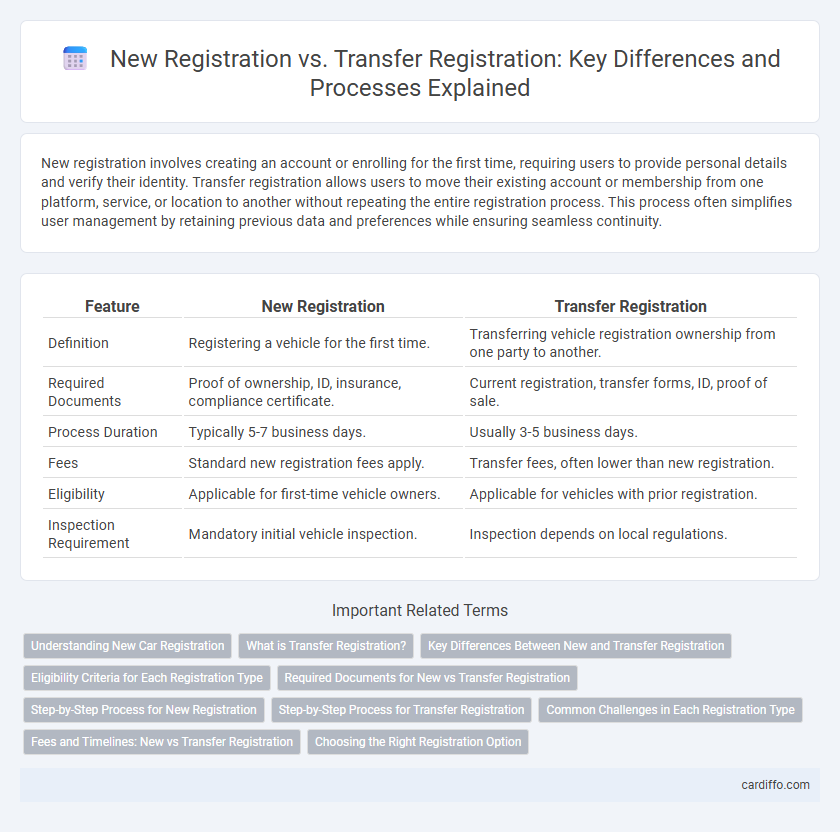New registration involves creating an account or enrolling for the first time, requiring users to provide personal details and verify their identity. Transfer registration allows users to move their existing account or membership from one platform, service, or location to another without repeating the entire registration process. This process often simplifies user management by retaining previous data and preferences while ensuring seamless continuity.
Table of Comparison
| Feature | New Registration | Transfer Registration |
|---|---|---|
| Definition | Registering a vehicle for the first time. | Transferring vehicle registration ownership from one party to another. |
| Required Documents | Proof of ownership, ID, insurance, compliance certificate. | Current registration, transfer forms, ID, proof of sale. |
| Process Duration | Typically 5-7 business days. | Usually 3-5 business days. |
| Fees | Standard new registration fees apply. | Transfer fees, often lower than new registration. |
| Eligibility | Applicable for first-time vehicle owners. | Applicable for vehicles with prior registration. |
| Inspection Requirement | Mandatory initial vehicle inspection. | Inspection depends on local regulations. |
Understanding New Car Registration
New car registration involves officially recording a vehicle's ownership and details with the Department of Motor Vehicles (DMV) or relevant authority for the first time, ensuring legal compliance and road usage rights. This process requires submitting necessary documents such as the bill of sale, proof of insurance, and vehicle identification number (VIN) verification. Unlike transfer registration, which updates ownership between parties, new registration establishes a vehicle's initial legal identity within the registration system.
What is Transfer Registration?
Transfer registration refers to the process of changing the ownership details of a vehicle or property from one individual or entity to another in official records. Unlike new registration, which involves recording a brand-new asset, transfer registration updates existing documentation to reflect new ownership. This procedure ensures legal compliance and accurate record-keeping for taxes, insurance, and liability purposes.
Key Differences Between New and Transfer Registration
New registration involves creating a record for a vehicle or entity that has not been previously registered in the given jurisdiction, requiring full documentation and compliance with initial registration requirements. Transfer registration occurs when ownership changes from one party to another, necessitating the submission of proof of ownership transfer, previous registration details, and payment of applicable transfer fees. Key differences include the scope of documentation, fees involved, and the process timeline, with new registrations generally requiring more extensive verification and longer processing times.
Eligibility Criteria for Each Registration Type
New registration applies to individuals or entities registering for the first time, requiring proof of identity, residency, and compliance with specific local regulations. Transfer registration involves the reclassification of ownership or status, necessitating valid documentation of prior registration and authorization from the original registrant. Eligibility for new registration mandates no prior involvement, whereas transfer registration requires verifiable proof of legitimate transfer rights.
Required Documents for New vs Transfer Registration
New registration requires documents such as a valid proof of identity, proof of address, and a completed application form, along with the original vehicle certificate if applicable. Transfer registration demands the original registration certificate, a duly signed transfer form by both parties, proof of insurance, and a valid emissions inspection certificate. Both processes may also require payment of applicable fees and taxes, but transfer registration specifically emphasizes ownership transfer documents.
Step-by-Step Process for New Registration
New registration requires completing an application form, submitting identification documents, and paying applicable fees to the registering authority. The process involves verifying ownership or eligibility, scheduling inspections if necessary, and receiving a registration certificate or number plate. Timely submission of all required paperwork ensures a smooth registration process without delays.
Step-by-Step Process for Transfer Registration
Transfer registration requires submitting the original registration certificate, proof of ownership, and a valid identification document to the relevant motor vehicle department. The process includes verifying vehicle details, paying transfer fees, and obtaining a new registration card in the transferee's name. Completing form submission and undergoing a possible vehicle inspection finalize the transfer registration efficiently.
Common Challenges in Each Registration Type
New registration often faces challenges such as verifying original ownership documents and ensuring compliance with regulatory requirements, which can delay processing times significantly. Transfer registration typically encounters issues related to inconsistencies in previous ownership records and the need for clear authorization from all parties involved, causing potential disputes. Both registration types require accurate data entry and validation to minimize errors and streamline the registration process.
Fees and Timelines: New vs Transfer Registration
New registration fees typically include initial application charges and possible inspection costs, often resulting in a higher upfront expense compared to transfer registration fees, which are generally lower and focused on administrative processing. Timelines for new registrations usually take longer, ranging from 7 to 15 business days due to verification and documentation checks, whereas transfer registrations are completed faster, often within 3 to 7 business days. Understanding these differences helps applicants budget and plan effectively when deciding between new vehicle registrations or ownership transfers.
Choosing the Right Registration Option
Choosing the right registration option depends on whether you are a first-time user or transferring existing credentials. New registration involves creating a completely new account with unique identification details, while transfer registration requires linking or migrating previous records to maintain continuity. Evaluating eligibility criteria and intended use will help determine if a fresh registration or a transfer is more appropriate for your specific needs.
New Registration vs Transfer Registration Infographic

 cardiffo.com
cardiffo.com